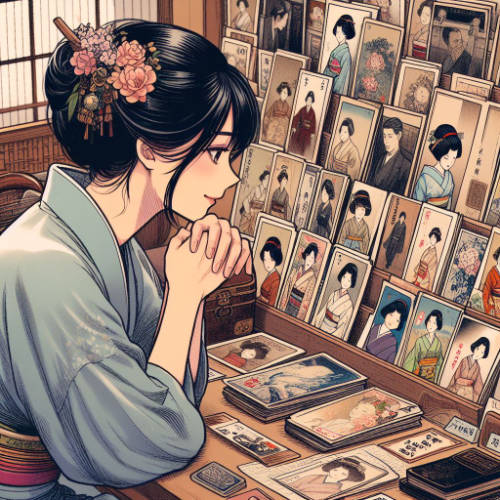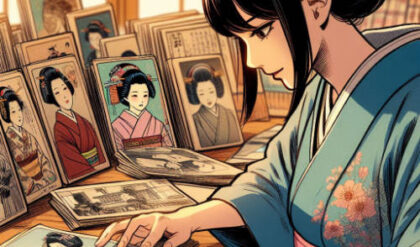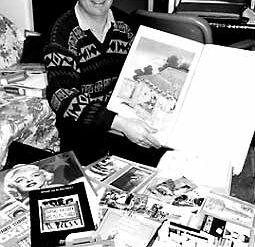by Philbert Ono, Updated: Feb. 3, 2025

I have vintage Japanese postcards about 50 to 80 years old, how much are they worth?
As with most antique items, the value is determined only by how much the seller is willing to sell it for and how much a buyer is willing to pay for it. The value depends not only on the postcard (rarity, condition, etc.) itself, but also on the seller and buyer. Remember the old adage, “One person’s trash is a another person’s treasure.” (And vice versa.)
Also, when you want to sell postcards, you can either sell them to a postcard dealer or to a direct customer. A postcard dealer will buy your postcards only at a fraction of the price he would resell the cards for. So it would be smart to sell directly to someone willing to buy your cards.
If you are really serious in judging the worth of your postcards, you should attend one of the many postcard fairs and shows held in the U.S. and Europe. This is where postcard dealers gather to sell to collectors. Look for dealers who have Japanese vintage postcards and browse through their stock and note the prices. You can get a fairly good idea of current selling prices.
In Japan, postcard dealers gather at stamp shows and antique fairs. If you happen to be in Tokyo during a stamp show, you could browse through the stock of vintage postcards and get a good idea of prices. Generally speaking, landscapes, scenics, temples, shrines, and other non-people postcards have the least value unless they are hand-painted or hand-tinted. Japanese beauties (Nihon bijin) such as geisha with hand-tinting seem to have the highest prices. For a single postcard, a price of ¥3,000 to ¥5,000 can be considered very high. It is rare to see any postcard priced higher than this. On the low end, black-and-white, vintage postcards of unimpressive landscape and scenics may sell for a few hundred yen or less.
So where can I sell my vintage postcards in Japan? Can you list a few postcard dealers?
Internet auction sites like Yahoo! Japan Auctions (Japanese language required) and eBay would be best. eBay’s postcard section probably has a larger selection than any store in Japan.
So when and where are those stamp shows and antique fairs where I can buy vintage postcards in Japan?
One large stamp fair is JAPEX, held in autumn in Tokyo (Asakusa).
How much do postcards cost in Japan?
For vintage postcards, normally anywhere from 100 yen to a few thousand yen. New postcards issued by the Japan Post Office are 52 yen (with stamp).
How much does it cost to send a postcard in Japan?
It costs ¥63 within Japan as of Jan. 2024. Also see International Postal Rates.
What types of postcards does the Japan Post Office sell?
There are several types of postcards which the post office sells. Besides the plain postcard which sells for 52 yen (including the printed stamp), there is a variety of postcards with pictures:
Picture postcards (e-iri hagaki)
These postcards have full-side or large pictures on the front side.
Hometown postcards (furusato e-hagaki)
Sold by the local post office, these cards feature small pictures of the local area’s sites and scenes.
Seasonal greeting postcards
Four types of seasonal postcards (all include a printed postage stamp) are issued by the post office:
- New Year’s postcards (nenga hagaki)
These are the most popular since they are like Christmas cards in the U.S. These cards have lottery numbers for various prizes. The cards sold by the post office are plain with no pictures. But private companies also buy these cards and resell them after printing a picture or message on them. Photo labs also buy them and make photo New Year’s cards. Sold in November. - Spring greeting cards (Nicknamed “Sakura mail“)
Postcards for school entrance congratulations, graduation, and employment. The cards typically have a picture of spring flowers, etc. Sold in February. - Summer greetings cards (Nicknamed “Kamo mail“)
These postcards have lottery numbers. They number a far second to New Year’s cards. Sold in June. - Fall greetings cards (Nicknamed “Heart mail“)
Mainly for the Respect-for-Aged Day on Sept. 15. Sold in Sept.
Economy postcards (Nicknamed “Eko hagaki“)
These cards feature advertising on the address side and they cost ¥5 less than usual.
International postcards (Kokusai yuubin hagaki)
These cost ¥70 for any place outside Japan via air mail.
You can see the different types of postcards sold by the Japan Post Office here.
What are New Year’s postcards (nengajo)?
Japanese people send each other something like three billion New Year’s postcards (as of 2015), the equivalent of the Western custom of sending Christmas cards. This works out as an average of about 30 New Year greetings mailed for every Japanese person. They are usually decorated with pictures of the animal representing the coming year, according to the 12-animal Oriental zodiac. 2003 was the peak year with over 4.4 billion New Year’s postcards printed by the Japan Post Office. This number has been steadily declining since then with a little over 3 billion issued by 2015.
The custom of sending postcards at New Year became common only after 1871, when the Japanese postal system was established. If they are mailed by a certain date (after December 15th of the previous year), the cards are given a January 1st stamp and will be delivered on the first day of the new year, something to aim for! New Year cards are not only exchanged between friends, but also sent to business acquaintances, people who have done you a favor or kindness in the previous year, and those with whom you wish to establish good future relations.
The official New Year’s cards are lottery postcards; this was started in 1950. The drawing is held on January 15th and various prizes are given to those who received cards with the winning numbers. Traditionally each card are written carefully by hand, using special brushes and ink. Nowadays, many cards are printed with a personal computerat home, made easy with many software for this purpose. New Year cards are often highly individualized, containing news of personal events that occurred during the previous year or photos of the sender’s family.
However, with the advent of the Internet, smartphones, and popular messaging apps like LINE, many people have stopped buying, writing, and sending nengajo New Year’s postcards in Japan. After peaking in Jan. 2003 with 4.46 billion New Year’s postcards printed by the Japan Post Office, the number has shrunk to 1.67 billion for Jan. 2023. This number is continues to shrink significantly every year. In 2003, people sent an average of 35 New Year’s postcards. This decreased to 13.4 cards for Jan. 2023.
Can I write correspondence on the address side of the postcard?
Yes, you can write your message on the lower or left half of the address side as long as the name and address are clearly legible.
What are those red boxes which I see on Japanese postcards and envelopes?
Those boxes are for the postal code (equivalent to the zip code in the U.S.). Japan postal codes have 7 digits (it used to be 3 or 5 digits before Feb. 2, 1998). So you will see seven red boxes printed on most postcards and envelopes.
I want to make my own postcards. What are the required size and weight?
In Japan, postcards must be 9 cm to 10.7 cm high and 14 cm to 15.4 cm long. It must weigh 2 g to 6 g. (Postcards issued by the Japan Post Office measure 10 cm x 14.7 cm.)
Can I put on stickers, etc., on a postcard and send them?
Yes, you can stick on thin stickers or paper as long as the total weight does not exceed 6 grams.
I bought 40 postcards from the Japan Post Office, but I accidentally dropped them in a muddy puddle. They are ruined. What should I do?
You can return any postcards that you ruined (by ink spills, bad writing, etc.) to the post office and exchange them for new postcards for a fee that is cheaper than buying new replacement postcards. You can also do this for stamps.
I have an old Japanese postcard which has a stamp on it. How can I check the age of the stamp?
Get a copy of the Japanese Postage Stamp Catalog (Nihon Kitte Catalog published by JSDA). This wonderful annual booklet has a color image of all the stamps that Japan’s postal service has issued since the very beginning. It gives the stamp’s issue date, quantity printed, and approximate value. Although it’s in Japanese, the issue dates and stamp names are also given in English. The catalog is cheap.
Are there postcard fairs in Japan?
No, but there are stamp shows and antique fairs where postcards also sold. There are also flea markets held at shrines on weekends.
Are there postcard auctions in Japan?
At Yahoo! Japan Auctions (Japanese language required). However, eBay has a much larger selection.
Are there postcard collectors clubs in Japan?
Yes, but websites are in Japanese only.
・Japan Picture Postcard Society: https://nihon-ehagakikai.jp/
・Postcard Museum (in Kobe): https://www.ehagaki.org/muse_overview/
Are there postcard collector’s magazines or publications in Japan?
No magazines but there are a few books on Japanese postcards.
What’s Kokkei Shimbun?
See Andrew Watt’s article on this subject.
What are some of key words for Japanese postcard collectors?
Here are some helpful key words and phrases and their Japanese equivalents.
General Terms
postcard – hagaki
picture postcard – e-hagaki
postcards issued by the Japan Post Office – kansei hagaki
postcards made by private parties – shisei hagaki
stamp – kitte
envelope – fuuto
post office – yuubin-kyoku
date (Year, month, day) – nen-gappi
vintage postcards – furui e-hagaki
prepaid return-postcard – ofuku hagaki
picture postcard collecting – e-hagaki shu-shu
Postcard Themes
hand-colored postcards – te-saishiki e-hagaki 手彩色絵葉書
New Year’s postcards – nengajo 年賀状
summer greeting postcards – かもめーる (discontinued from 2021)
military – gunji 軍事
Russo-Japanese War – Nichiro senso 日露戦争
Emperor Meiji – Meiji Tenno 明治天皇
Emperor Taisho – Taisho Tenno 大正天皇
Emperor Hirohito – Showa Tenno 昭和天皇
disaster – saigai 災害
earthquake – jishin 地震
flood – kozui 洪水
transportation – kotsu 交通
airplanes – hikoki 飛行機
automobiles – kuruma 車
trains – densha, SL, kisha 電車、汽車
motorcycles – otobai オートバイ
bicycles – jitensha 自転車
rickshaw – jin-rikisha 人力車
passenger ships – kyakusen 客船
street scenes – machi-nami 街並み
landscape – fukei 風景
people – jinbutsu 人物
Japanese beauties – Nihon bijin 日本美人
geisha girl – geisha 芸者
children – kodomo 子供
kabuki actors – kabuki yakusha 歌舞伎役者
nudes – nuudo ヌード
flowers – hana 花
expositions – hakurankai 博覧会
advertising – kou-koku 広告
art noveau – aato nuboo アール・ヌーヴォー
overseas picture postcards (non-Japanese) – gaikoku e-hagaki 外国絵葉書
General Phrases
How much? (What’s the price?) – Ikura deska?
Do you have postcards? – Hagaki arimaska?
Postcard collecting is my hobby. – E-hagaki shu-shu wa shumi des.
Are you interested in postcard collecting? – E-hagaki shu-shu ni kyomi arimaska?
At the Post Office
Where’s the post office? – Yubin-kyoku wa doko deska?
I want 50-yen stamps.- Goju-en kitte wo kudasai.
How much is the stamp(s)? – Kitte wa ikura desuka?
I want thirty New Year’s postcards. – Sanju-mai no nengajo wo kudasai.
At the Postcard Shop
Where are the picture postcards? – E-hagaki wa doko desuka?
Do you have old (vintage) postcards? – Furui e-hagaki arimaska?
Postcard Guide Contents
・Introduction
・Japan’s postcard history and how to date old postcards
・Gallery of vintage Japanese postcards – Philbert Ono Collection
・Japanese postcard FAQ – Includes postcard glossary
・Kokkei Shimbun postcards – by Andrew Watt
・Japan Times article on Postcard Club and founder Jason Smith – by Angela Jeffs in 1997
・Book review of postcard books – Meiji Period postcards
・Book review of Yokohama postcard book
・T. Enami – Yokohama-based photographer active in the 1920-30s
・Vintage Postcard Shops in Osaka
・Year Conversion Table – Figure out what year Meiji 5 was, etc.





2 Comments